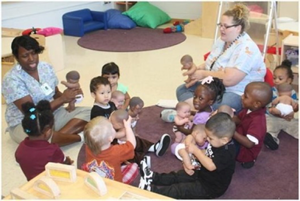Lesson 8: Circle Observation and Lesson Plan
Attention

Learning Outcomes
Upon completion of this lesson's material, students will be able
- Complete the use of the anecdotal record observation technique
- Use the anecdotal record to inform lesson planning
- Implement lesson plan that was created based on anecdotal record findings
- Reflect upon observation as a technique to gather data and improve practice
- Explain the importance of circle time in early care settings
Teaching
Plan ahead to observe circle time in your site. From using an anecdotal method, you will observe “circle time” and use your observations to create a lesson plan. Your lesson plan will be implemented within that week so be sure to plan ahead.
What is a circle time??? Circles are an ancient, universal symbol of unity and wholeness. Circle time has been around for about a century but you have to wonder how it originated. For longer than a century, cultures gather around to eat in a circle, dance around a fire in a circle, hold hands in a circle, etc. For children, we have customized circle time to do weather charts, sing songs and listen to stories. We have created that time to give all children instruction and formal education. But what does that mean for younger children?
The base of circle time should revolve around social and emotional skills. It IS about unity and wholeness! It is an added bonus that you can add other developmental domains into that specific time. Early childhood settings will often set a time to attempt a circle for infants and toddlers but set realistic expectations on the actual participation. Often it is a song or simple finger play. In Head Start settings they use Baby Doll Circle Time. Although participation is not required the model sets a fun tone that children often do not want to miss out on.
Anecdotal records are short, factual, narrative descriptions of child behaviors and skills. They should OBJECTIVE and only a few sentences long. A lot of early childhood programs use this technique for observation taking because it is quick allows teachers to track progress. It also provides concrete evidence (if objective) for assessment and discussions with families. Please see the tip sheet and provided examples for further information to assist you with your assignment.
Anecdotal records teacher tips
Three anecdotal examples
Assessment
Lesson 8 Assignment
You will be using the Anecdotal Form and the Lesson Plan Form for this assignment.
Observation
- Decide why you are observing circle time (aside from its required in this course). What is the objective?
- What are you hoping to gain from the observation?
- Will you be observing one child for all of circle or ALL children during circle?
- Choose a time that best works for you and the site to observe circle time.
- Use the ANECDOTAL FORM provided to complete the observation
Planning
- In the comments section of the ANECDOTAL FORM write your analysis or interpretation of the observations
- What is the observation telling you? How does this relate to your lesson plan?
- Create a lesson plan using the LESSON PLAN FORM (do only the first two sections).
- Assure this is related to your observation and observation objective.
- Review the LESSON PLAN RUBRIC as you put your Lesson Plan together.
Implementation
- Implement your activity
- Complete self-assessment portion of the planning form. The third section in the LESSON PLAN FORM
Possible Class Discussion
What is your stance on “Circle time” for infants and toddlers? What do you believe the value is during this time of day?